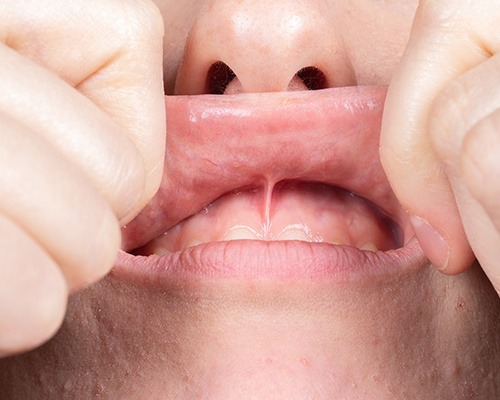Myofunctional Sleep Apnea Approach (Lip & Tongue Ties) – Las Vegas, NV
Better Sleep Through Myofunctional Therapy

“Myofunctional therapy” is an unfamiliar term for most people, but it actually offers a proven, non-invasive way to help people reduce and even stop obstructive sleep apnea symptoms. Its main goal is to retrain and strengthen the tongue and orofacial muscles to allow for better breathing during sleep while also preventing the airway from closing down. Often, this approach is necessary for children and adults who have or have had a lip or tongue-tie. Myofunctional exercises only take a few minutes a day to complete, but the long-term benefits cannot be understated.
Lip and Tongue-Ties in Kids and Adults

Each lip as well as your tongue are connected to a thin band of tissue called a frenum or frenulum. During the last stage of gestation right before birth, these tissues are supposed to loosen and elongate, enabling these parts of the mouth to move properly. Sometimes, however, this does not happen, resulting in short or tight frenums that restrict the tongue and/or lips. While often diagnosed in infants, it’s common for mild ties to remain undetected until someone is a teenager or adult.
Sleep Apnea + Lip & Tongue Tie: What to Know

Due to a lip or tongue tie, the muscles of a person’s mouth may not develop properly, causing them to be relatively weak or flaccid. In addition to making it harder to eat and speak, this also increases the chance of the airway collapsing during sleep, causing sleep apnea. While oral appliance therapy or CPAP therapy can help, they don’t fix the underlying problem, which is the incorrect function of the orofacial muscles. This is where myofunctional therapy can help.
What are Lip and Tongue-Ties?

As touched on above, myofunctional therapy is a collection of exercises designed to help the orofacial muscles work as they should. Once a lip or tongue tie has been treated (or “released”), the patient will be given a selection of exercises that teach them to swallow correctly, primarily breathe through their nose, and keep their tongue in the correct resting posture, all of which work to open up the airway and prevent obstructions during sleep.
A Myofunctional Approach to Treating Lip & Tongue-Ties

When a patient comes to see Dr. West, as part of her exam, she’ll look for the presence of a lip or tongue tie as well as the signs that someone might have had one in the past. Some patients who have had these conditions treated have not gone through the myofunctional process, and therefore, their muscles and airway may still be working improperly. Once a patient’s lip and tongue-tie have been treated, Dr. West can prescribe a range of daily exercises that will enhance the airway, which can reduce snoring and stoppages in breathing to improve sleep quality. The best part about this kind of treatment is that the results last for a lifetime.
Myofunctional Therapy FAQs
How Does Myofunctional Therapy Work?
Myofunctional therapy is a set of exercises that help correct orofacial myofunctional disorders—issues with the way the mouth and facial muscles function. These problems can be caused by blocked nasal passages, poor tongue posture, or prolonged habits like thumb sucking. The therapy focuses on improving tongue position, lip seal, and nasal breathing through neuromuscular training. It can help with snoring, sleep apnea, speech issues, tongue thrust, and recovery after certain surgeries, and may offer some support for TMJ and tongue-tie when combined with other treatments.
At What Age Should Myofunctional Therapy Be Considered?
Addressing myofunctional concerns early can make a big difference in preventing future issues. No matter what your age, it’s a great time to take that first step. While our approach is tailored for kids 5 and up as well as adults, younger children—including infants and toddlers—can still benefit from simple interventions like tongue-tie releases and gentle exercises that support healthy development. If you're unsure where to begin or want to explore options for your child, feel free to schedule a consultation so that our team can help you understand what’s possible and how we can support your family’s needs.
Why Do I Need Myofunctional Therapy?
Orofacial myofunctional disorders (OMDs)—such as mouth breathing, low tongue posture, tongue-tie, open-mouth resting posture, or an improper swallowing pattern—can have wide-ranging effects on your overall well-being. In children, these issues may contribute to challenges with feeding, digestion, speech development, breathing during sleep (like snoring or sleep apnea), and alignment of the teeth and jaws. If left unaddressed, these patterns can lead to ongoing concerns into adulthood, including jaw discomfort, teeth grinding, neck tension, chronic headaches, disrupted sleep, and even relapse after orthodontic treatment. Addressing these concerns early can help guide healthy development, ease current symptoms, and reduce the risk of future complications—supporting a more balanced and comfortable life.
How Does Myofunctional Therapy Help Sleep Apnea?
Obstructive sleep apnea happens when the muscles around the throat relax too much during sleep, causing the airway to collapse and block airflow. Myofunctional therapy works to strengthen these muscles, enhance tongue position, and promote nasal breathing—all of which support a clearer, more stable airway. While CPAP is a common and effective treatment that uses steady air pressure through a mask, many people find it difficult to maintain long-term. Interestingly, a small study suggested that combining myofunctional therapy with CPAP may improve comfort and help patients stay consistent with their treatment.
